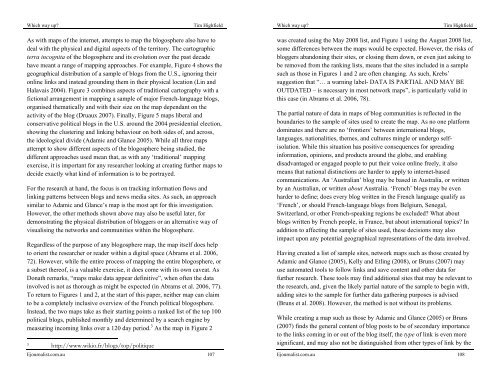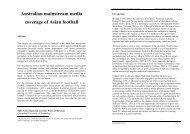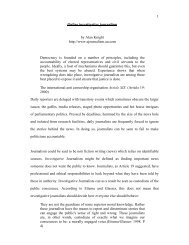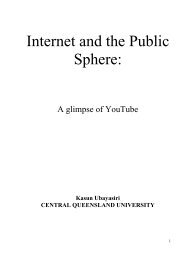Reading and drawing maps of the blogosphere. - eJournalist
Reading and drawing maps of the blogosphere. - eJournalist
Reading and drawing maps of the blogosphere. - eJournalist
You also want an ePaper? Increase the reach of your titles
YUMPU automatically turns print PDFs into web optimized ePapers that Google loves.
Which way up? Tim Highfield<br />
As with <strong>maps</strong> <strong>of</strong> <strong>the</strong> internet, attempts to map <strong>the</strong> <strong>blogosphere</strong> also have to<br />
deal with <strong>the</strong> physical <strong>and</strong> digital aspects <strong>of</strong> <strong>the</strong> territory. The cartographic<br />
terra incognita <strong>of</strong> <strong>the</strong> <strong>blogosphere</strong> <strong>and</strong> its evolution over <strong>the</strong> past decade<br />
have meant a range <strong>of</strong> mapping approaches. For example, Figure 4 shows <strong>the</strong><br />
geographical distribution <strong>of</strong> a sample <strong>of</strong> blogs from <strong>the</strong> U.S., ignoring <strong>the</strong>ir<br />
online links <strong>and</strong> instead grounding <strong>the</strong>m in <strong>the</strong>ir physical location (Lin <strong>and</strong><br />
Halavais 2004). Figure 3 combines aspects <strong>of</strong> traditional cartography with a<br />
fictional arrangement in mapping a sample <strong>of</strong> major French-language blogs,<br />
organised <strong>the</strong>matically <strong>and</strong> with <strong>the</strong>ir size on <strong>the</strong> map dependant on <strong>the</strong><br />
activity <strong>of</strong> <strong>the</strong> blog (Druaux 2007). Finally, Figure 5 <strong>maps</strong> liberal <strong>and</strong><br />
conservative political blogs in <strong>the</strong> U.S. around <strong>the</strong> 2004 presidential election,<br />
showing <strong>the</strong> clustering <strong>and</strong> linking behaviour on both sides <strong>of</strong>, <strong>and</strong> across,<br />
<strong>the</strong> ideological divide (Adamic <strong>and</strong> Glance 2005). While all three <strong>maps</strong><br />
attempt to show different aspects <strong>of</strong> <strong>the</strong> <strong>blogosphere</strong> being studied, <strong>the</strong><br />
different approaches used mean that, as with any ‘traditional’ mapping<br />
exercise, it is important for any researcher looking at creating fur<strong>the</strong>r <strong>maps</strong> to<br />
decide exactly what kind <strong>of</strong> information is to be portrayed.<br />
For <strong>the</strong> research at h<strong>and</strong>, <strong>the</strong> focus is on tracking information flows <strong>and</strong><br />
linking patterns between blogs <strong>and</strong> news media sites. As such, an approach<br />
similar to Adamic <strong>and</strong> Glance’s map is <strong>the</strong> most apt for this investigation.<br />
However, <strong>the</strong> o<strong>the</strong>r methods shown above may also be useful later, for<br />
demonstrating <strong>the</strong> physical distribution <strong>of</strong> bloggers or an alternative way <strong>of</strong><br />
visualising <strong>the</strong> networks <strong>and</strong> communities within <strong>the</strong> <strong>blogosphere</strong>.<br />
Regardless <strong>of</strong> <strong>the</strong> purpose <strong>of</strong> any <strong>blogosphere</strong> map, <strong>the</strong> map itself does help<br />
to orient <strong>the</strong> researcher or reader within a digital space (Abrams et al. 2006,<br />
72). However, while <strong>the</strong> entire process <strong>of</strong> mapping <strong>the</strong> entire <strong>blogosphere</strong>, or<br />
a subset <strong>the</strong>re<strong>of</strong>, is a valuable exercise, it does come with its own caveat. As<br />
Donath remarks, “<strong>maps</strong> make data appear definitive”, when <strong>of</strong>ten <strong>the</strong> data<br />
involved is not as thorough as might be expected (in Abrams et al. 2006, 77).<br />
To return to Figures 1 <strong>and</strong> 2, at <strong>the</strong> start <strong>of</strong> this paper, nei<strong>the</strong>r map can claim<br />
to be a completely inclusive overview <strong>of</strong> <strong>the</strong> French political <strong>blogosphere</strong>.<br />
Instead, <strong>the</strong> two <strong>maps</strong> take as <strong>the</strong>ir starting points a ranked list <strong>of</strong> <strong>the</strong> top 100<br />
political blogs, published monthly <strong>and</strong> determined by a search engine by<br />
measuring incoming links over a 120 day period. 3 As <strong>the</strong> map in Figure 2<br />
3 http://www.wikio.fr/blogs/top/politique<br />
Ejournalist.com.au 107<br />
Which way up? Tim Highfield<br />
was created using <strong>the</strong> May 2008 list, <strong>and</strong> Figure 1 using <strong>the</strong> August 2008 list,<br />
some differences between <strong>the</strong> <strong>maps</strong> would be expected. However, <strong>the</strong> risks <strong>of</strong><br />
bloggers ab<strong>and</strong>oning <strong>the</strong>ir sites, or closing <strong>the</strong>m down, or even just asking to<br />
be removed from <strong>the</strong> ranking lists, means that <strong>the</strong> sites included in a sample<br />
such as those in Figures 1 <strong>and</strong> 2 are <strong>of</strong>ten changing. As such, Krebs’<br />
suggestion that “… a warning label- DATA IS PARTIAL AND MAY BE<br />
OUTDATED – is necessary in most network <strong>maps</strong>”, is particularly valid in<br />
this case (in Abrams et al. 2006, 78).<br />
The partial nature <strong>of</strong> data in <strong>maps</strong> <strong>of</strong> blog communities is reflected in <strong>the</strong><br />
boundaries to <strong>the</strong> sample <strong>of</strong> sites used to create <strong>the</strong> map. As no one platform<br />
dominates <strong>and</strong> <strong>the</strong>re are no ‘frontiers’ between international blogs,<br />
languages, nationalities, <strong>the</strong>mes, <strong>and</strong> cultures mingle or undergo selfisolation.<br />
While this situation has positive consequences for spreading<br />
information, opinions, <strong>and</strong> products around <strong>the</strong> globe, <strong>and</strong> enabling<br />
disadvantaged or engaged people to put <strong>the</strong>ir voice online freely, it also<br />
means that national distinctions are harder to apply to internet-based<br />
communications. An ‘Australian’ blog may be based in Australia, or written<br />
by an Australian, or written about Australia. ‘French’ blogs may be even<br />
harder to define; does every blog written in <strong>the</strong> French language qualify as<br />
‘French’, or should French-language blogs from Belgium, Senegal,<br />
Switzerl<strong>and</strong>, or o<strong>the</strong>r French-speaking regions be excluded? What about<br />
blogs written by French people, in France, but about international topics? In<br />
addition to affecting <strong>the</strong> sample <strong>of</strong> sites used, <strong>the</strong>se decisions may also<br />
impact upon any potential geographical representations <strong>of</strong> <strong>the</strong> data involved.<br />
Having created a list <strong>of</strong> sample sites, network <strong>maps</strong> such as those created by<br />
Adamic <strong>and</strong> Glance (2005), Kelly <strong>and</strong> Etling (2008), or Bruns (2007) may<br />
use automated tools to follow links <strong>and</strong> save content <strong>and</strong> o<strong>the</strong>r data for<br />
fur<strong>the</strong>r research. These tools may find additional sites that may be relevant to<br />
<strong>the</strong> research, <strong>and</strong>, given <strong>the</strong> likely partial nature <strong>of</strong> <strong>the</strong> sample to begin with,<br />
adding sites to <strong>the</strong> sample for fur<strong>the</strong>r data ga<strong>the</strong>ring purposes is advised<br />
(Bruns et al. 2008). However, <strong>the</strong> method is not without its problems.<br />
While creating a map such as those by Adamic <strong>and</strong> Glance (2005) or Bruns<br />
(2007) finds <strong>the</strong> general content <strong>of</strong> blog posts to be <strong>of</strong> secondary importance<br />
to <strong>the</strong> links coming in or out <strong>of</strong> <strong>the</strong> blog itself, <strong>the</strong> type <strong>of</strong> link is even more<br />
significant, <strong>and</strong> may also not be distinguished from o<strong>the</strong>r types <strong>of</strong> link by <strong>the</strong><br />
Ejournalist.com.au 108








